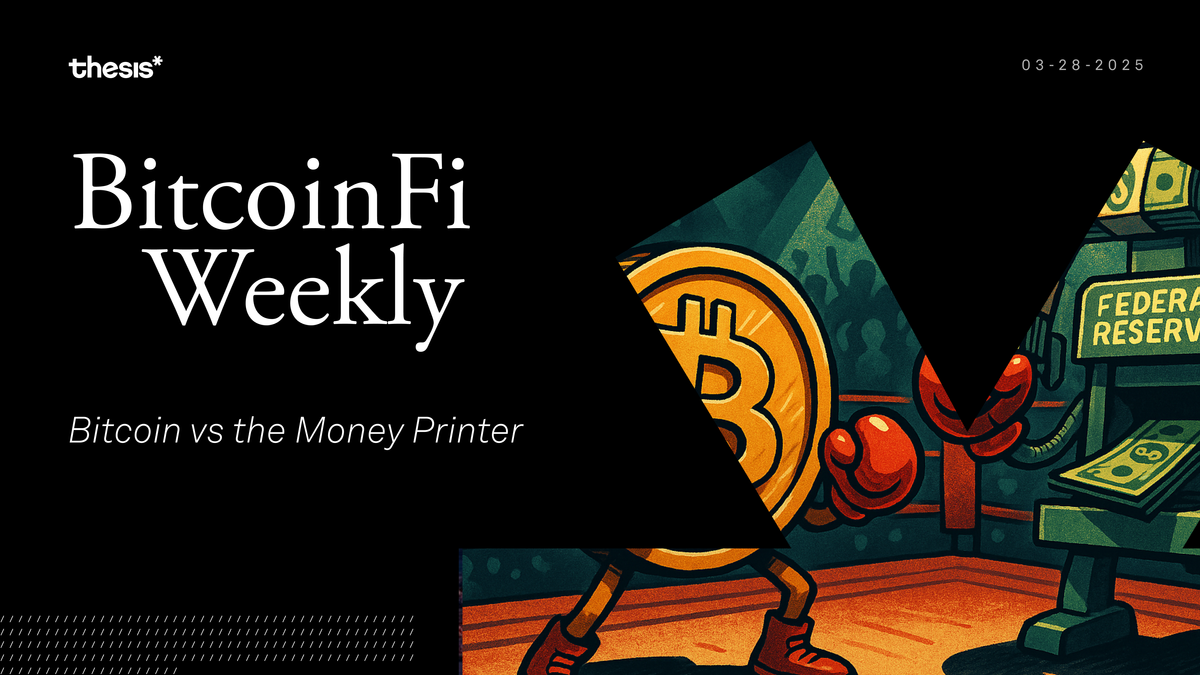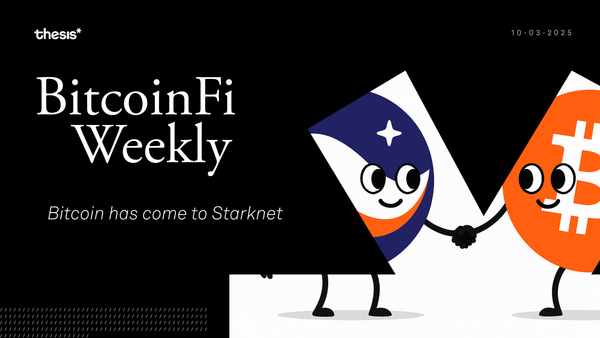Bitcoin vs the Money Printer
Fiat systems always expand—labels change, but money is still printed. These moves dilute value and highlight the contrast versus Bitcoin’s fixed supply.

Welcome to BitcoinFi Weekly. We cover where people use their BTC and what is changing in the Bitcoin world.
It’s often said that history doesn’t repeat, but it always rhymes. The faces change, but the song is the same: money is printed, and things fall apart slowly. Then quickly. A trillion here, a trillion there. Someone somewhere says this is different, while someone else nods because it sounds clever. And so the central banks spin up again, pumping liquidity like it’s air in a drowning room. The suits pretend to tame volatility while manufacturing its root cause. Meanwhile, Bitcoin waits patiently. Issuance unchanged. Supply capped. Unimpressed.
Here’s this week’s rundown:
💰 Feature piece: To QE or Not To QE
🧩 Galaxy OP_CAT & OP_CTV Assessment
⚡ Bitcoin Mining Lifts Rural Africa Out of Energy Poverty
🌽 Corn TGE
🧙♂️ Taproot Wizards Launch
Feature Piece: To QE or Not To QE
There's a certain predictability to central banking cycles. Markets wobble, financial experts convene, and suddenly, we're introduced to a new vocabulary for what is essentially the same old intervention mechanism. This is exactly what is happening at the Fed these days. A game of semantics, of sorts.
Economists from Brookings, Harvard, and Columbia suggested in a recent paper that during financial crises, the Fed should step in to unwind heavily leveraged hedge fund positions. Hedge funds are heavily engaged in basis trades, which involve exploiting small price differences between Treasury securities and their derivatives (i.e., futures). Currently, these arbitrage bets total around $1 trillion, twice the size of similar positions that triggered Fed intervention in 2020 during the onset of COVID.
In 2020, the Fed directly bought approximately $1.6 trillion in Treasury securities, flooding markets with liquidity. This new proposal, however, aims to be subtler, involving hedged bond purchases instead of outright purchases. This means the Fed would run auctions for bundled basis packages, where primary dealers would simultaneously sell Treasury securities and buy offsetting futures contracts. By setting a minimum bid price, the Fed aims to maintain discipline and limit moral hazard, though inevitably, the result is still an increase in the monetary base. Printer go brrrr, as the kids say.
This is great for Bitcoin. Bitcoin’s price has long followed a simple relationship: the more fiat there is competing for a fixed supply, the higher the price climbs. The amount of fiat is not fixed. It grows. It’s made up. Central banks make more whenever they feel they need to. The amount of bitcoin is fixed. 21 million coins. That’s it.
The proposed basis facility directly illustrates this dynamic. The Fed would, under the guise of market stabilization, create new money to purchase these bundled financial packages, quietly expanding the monetary base while framing the action as routine market operations. “QE-not-QE”, as Arthur Hayes calls it.
Fiat monetary systems invariably trend back toward expansion. It’s happened before, it’ll happen again. When esoteric financial maneuvers like this happen, they primarily serve to draw semantic distinctions about what’s really going on: money printing. It’s in moments like this, that the practical and mathematical implications for genuinely scarce assets like Bitcoin become starkly evident.
BitcoinFi Updates
Galaxy OP_CAT & OP_CTV Assessment
In a recent deep-dive, Galaxy Research outlines why 2025 could be the year Bitcoin developers reach consensus on long-awaited improvements to Bitcoin Script: OP_CAT (BIP 347) and OP_CTV (BIP 119). In case you’ve been living under a rock, OP_CAT lets scripts concatenate data, and OP_CTV commits transaction outputs to specific templates, to put it simply.
These upgrades would enable three crucial applications that Bitcoin currently lacks:
- Trustless Bridges - Eliminating the need for centralized custodians (like WBTC) when moving Bitcoin between different networks and layers
- Advanced Self-Custody - Creating sophisticated vault solutions with recovery paths and time-delays to protect funds from theft
- Lightning Network Improvements - Enabling channel factories and shared UTXOs that could dramatically improve scaling and efficiency
Bitcoin Mining Lifts Rural Africa Out of Energy Poverty
In more uplifting news than usual, the BBC recently profiled a Bitcoin mining operation in northwestern Zambia run by Gridless, a Kenya-based company focused on using off-grid energy to support both mining and local electrification. The mine draws directly from the Zengamina hydroelectric plant. Prior to the arrival of the mine, the plant was underutilized and unable to cover operating expenses. With the mine now accounting for roughly 30% of its revenue, the plant is financially sustainable and exploring expansion to other villages.
Here, we have a real-world application of how Bitcoin mining can monetize surplus electricity and support mini-grid infrastructure in areas that otherwise struggle to fund it. While the piece ends with several inaccurate claims (including mischaracterizations of Greenidge, energy grid strain, and the idea that mining requires government oversight to act responsibly), it also marks a shift in tone for the BBC, which until now has mostly focused on negative Bitcoin coverage. It’s one of the outlet’s first stories to depict Bitcoin mining as a useful tool for energy development, and that makes it notable.
Corn TGE
Corn, a BitcoinFi-focused Ethereum Layer 2 network, has announced the launch of its native token $CORN. The network uses a hybrid tokenized Bitcoin (BTCN) as its gas token and redirects network yield back to users and protocols. With a total supply of 2.1 billion tokens, 52% has been allocated to the community through various incentive programs.
$CORN launched with an initial circulating supply of 525 million tokens (25% of total supply), focusing on community growth and ecosystem development. The token distribution includes several phases of pre-launch incentives and two new programs: Cornfields Season 1 for network-wide incentives and a $CORN locking mechanism that allows users to earn more tokens by locking their holdings for 21 weeks.
The token implementation is designed to align incentives between users, applications, and token holders through the "popCORN" system, which allows stakers to direct token emissions to protocols on the network. This governance mechanism gives token holders influence over where incentives flow, creating what the team describes as the original "veCHAIN."
Taproot Wizards Launch
Taproot Wizards completed their long-anticipated mint, distributing 2,121 inscriptions to mint wallets. Co-founded by Udi Wertheimer and Eric Wall, Taproot Wizards are one of the earliest and most visible efforts to build culture natively on Bitcoin using Ordinals. Launching at .2 BTC, the collection has already seen over 52.8 BTC in trading volume, with a floor price of 0.23 BTC and 1,600 holders across the 2.1K supply.
The Wizards drew inspiration from the 2013 "Magic Internet Money" Reddit meme that helped popularize Bitcoin a decade ago. But more importantly, the project openly challenges Bitcoin’s cultural ossification, using inscriptions as a canvas to restore what it sees as the network’s lost spirit of experimentation. The team, which recently raised $7.5M led by Standard Crypto, has been vocal in framing the project as more of a bid to reopen Bitcoin’s culture to builders, creators, and non-maximalist users.
Closing Thoughts
In time, all that is false collapses beneath the weight of its contradictions. What remains is not what shouted loudest, but what endured. Fiat promises float on tides of policy and fear, while Bitcoin carries within it something deeply human: a belief that truth does not require permission. The future, if it is to be free, will be built on ledgers that do not lie.
Thank you for tuning in to this week’s BitcoinFi Weekly. See you next week.
If there's a topic you’d like us to cover or have questions, reach out at [email protected].
Learn more about Mezo at the following channels:
👾 Discord: https://discord.mezo.org
🕊 X: https://twitter.com/MezoNetwork
🖥 Website: https://mezo.org
🏦 Deposit Portal: https://mezo.org/hodl
ℹ️ Docs: https://info.mezo.org





